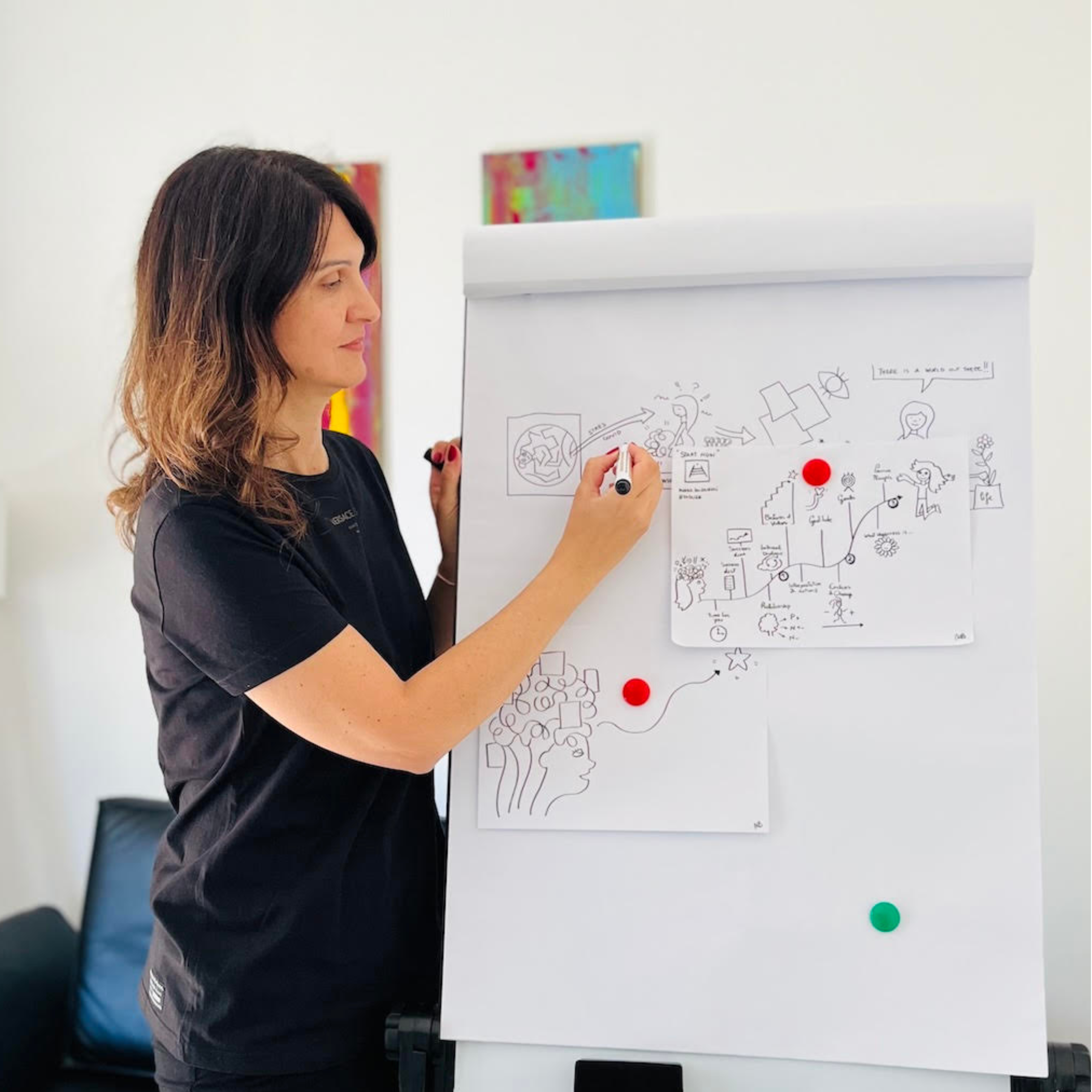One of the core concepts we explore during the Design for Change class at Hyper Island is Change Leadership, and what it really means to become a change leader in today’s rapidly evolving world. We define change leaders – or C-Leaders – as individuals who take action to create a positive and sustainable impact, and who lead others toward a desired future state and shared vision. These people may hold leadership titles, but just as often, they do not. What defines them is not formal authority, but mindset, courage, and influence. They take responsibility for transformation, not because someone told them to, but because they see a better way forward and are willing to bring others along on the journey. They lead through complexity with empathy, confidence, and a deep sense of purpose.
In class, we explore many practical tools and canvases that can support us throughout a change initiative. But at the very beginning of any transformation, two elements are especially critical: one is a mindset, and the other is a tool (or many tools depending on needs…). The mindset we introduce is based on the Plan–Do–Check–Act (PDCA) cycle. Originally developed by Dr. W. Edwards Deming, this simple yet powerful framework encourages us to embrace action and learning as an ongoing loop. But in the context of change leadership, we don’t treat PDCA as a tool or rigid process for project management – we treat it as a way of thinking. The PDCA mindset enables us to move forward without needing every detail figured out. It helps us act intentionally (Plan), test in real-life contexts (Do), stay curious and observant about the effects of our actions (Check), and evolve our strategies based on what we’ve learned (Act). This mindset invites flexibility, welcomes feedback as a gift, and supports continuous adaptation – three capabilities that are absolutely essential for any change leader. Adopting a PDCA mindset helps us build confidence in uncertainty, shift from perfectionism to experimentation, and remain grounded in reflection and growth. Since my career in the quality assurance and ISO standards field I have been using this simple but powerful model as a framework for everything I do.
Alongside this mindset, one of the most impactful change tools I usually use in the early stages of a project is the Change Agents Map. This tool helps you map out the people around you – within your team, organisation, or network – who could influence the success of your initiative. These allies may be formal change agents, innovation managers, or transformation leads. But just as often, they are informal influencers: respected colleagues, outspoken creatives, problem solvers, or tech experts whose voices carry weight. Some are innovators who bring new ideas and challenge the status quo. Others are influencers who help shape opinion, even without a formal title. Mapping them gives you an immediate sense of who might support you, who might resist, and where you might need to build new connections or strengthen relationships. It’s an act of self-reflection and strategic awareness that enables you to be proactive in involving the right people from the start. And it reinforces a simple but essential truth: we never lead change alone. We lead it through others – by building trust, aligning vision, and mobilising shared energy.
Throughout the Design for Change course, we look at leadership not as something static or hierarchical, but as something dynamic and human. We explore how the role of the leader is shifting – from being the one with all the answers to being the one who creates the conditions for others to grow, contribute, and take part in transformation. The traditional idea of leadership is giving way to something far more inclusive and relational. Influence, not position, becomes the new currency.
One of the models we introduce to support this evolution is based on six fundamental areas that every C-Leader needs to cultivate: confidence, the inner strength to take initiative even without guarantees; clarity, the ability to communicate direction and purpose in the midst of complexity; a change mindset, which embraces uncertainty as an opportunity rather than a threat; co-creation, the willingness to build solutions together with others rather than in isolation; and creativity and care, which allow us to lead with empathy, imagination, and responsibility. These six areas form a holistic foundation for sustainable leadership and help us understand how personal development and collective transformation are deeply interconnected.
The C-Model: Turning Intent into Action
To help structure a real, concrete change plan, we also introduce the C-Model – The 3 Pillars of Change. This framework allows you to turn intention into action and build a clear roadmap for transformation. The three pillars are: Communication, ensuring transparency, clarity, and narrative alignment; Community, creating shared ownership and mobilising internal advocates; and Capabilities, developing the skills, tools, and resources people need to move confidently through change. These pillars serve as a strategic foundation for any C-Leader who wants to design and deliver a change plan that is not only structured but also human-centred and impactful.
Change Leadership Is a Way of Being
When we combine the PDCA mindset, the practical change tools, the development of the six core C-Leader qualities, and the strategic application of the C-Model, we begin to see how change leadership is not just about managing a process – it’s about cultivating a way of being. It’s about approaching uncertainty with clarity of intent, engaging others with empathy, and designing action with a willingness to adapt. It’s about listening carefully, learning constantly, and acting with courage even when the outcome is not guaranteed.
In the end, becoming a C-Leader doesn’t require a specific title or years of experience. It requires the willingness to start. To try. To bring others with you. To reflect and improve. Change leaders don’t just implement strategies – they create movement. They make change feel possible, meaningful, and shared. And in a world where transformation is the new normal, that is a capability we cannot afford to ignore.
Curious to Explore Your Own Leadership Journey?
If Moira's reflection on change leadership sparked something in you – a curiosity, a question, a desire to lead with more confidence – you're not alone.
At Hyper Island, our Upskill courses are designed to help professionals develop the tools, mindset, and practical experience needed to lead real transformation.
Explore our upskill courses.


WANT TO GET NOTIFIED ABOUT OUR EVENTS?
Join our mailing list for tips, events, and opportunities.

